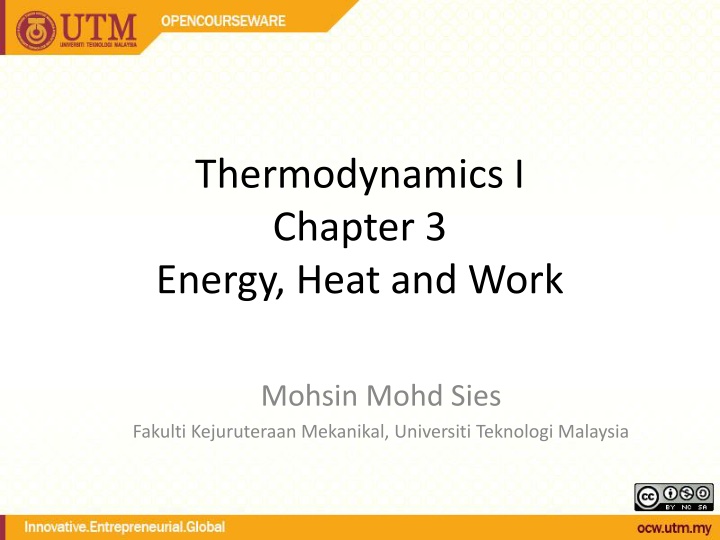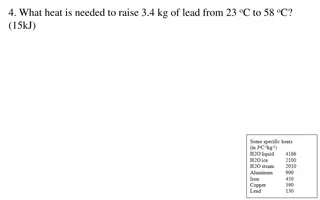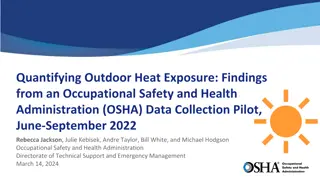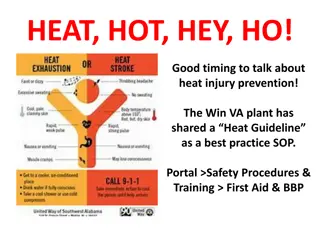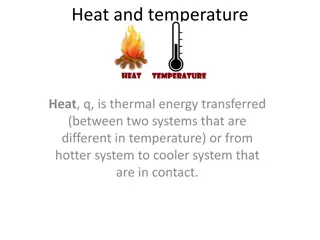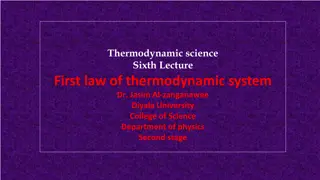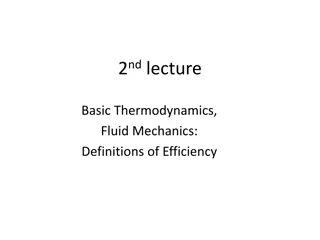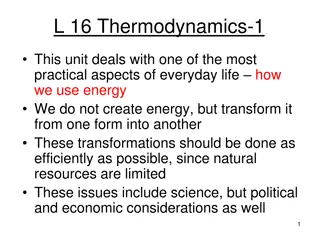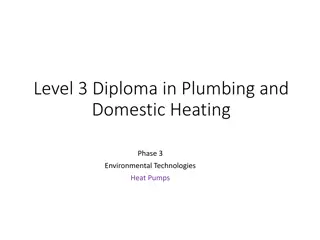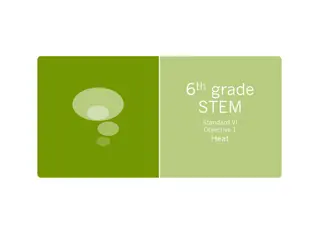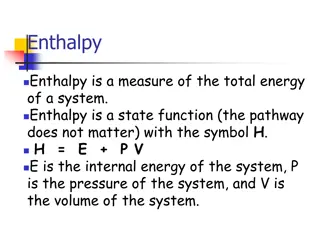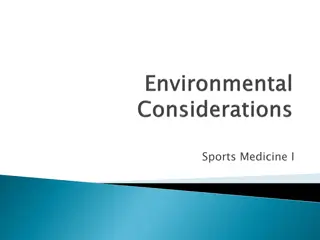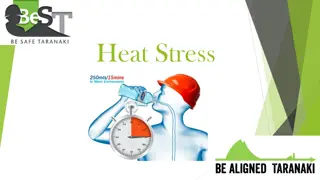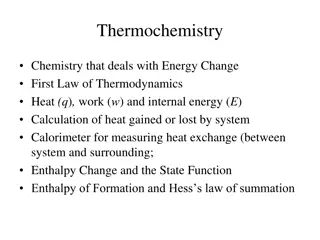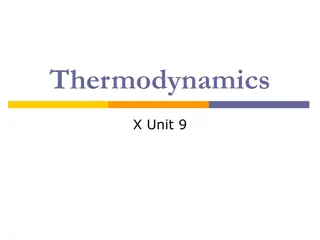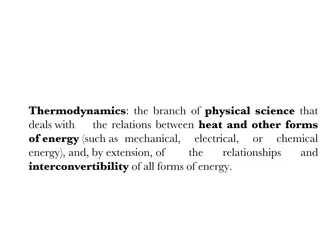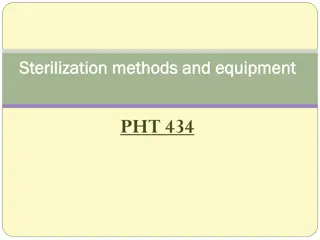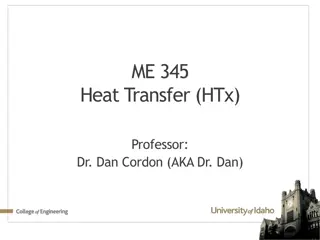Energy, Heat, and Work: Understanding Thermodynamics Fundamentals
Dive into the fundamentals of thermodynamics as you explore the concepts of energy, heat, and work within a system. Discover how energy interacts with its surroundings and changes forms, and learn about the conservation of energy, various energy types, and the first law of thermodynamics. Gain insights into macroscopic and microscopic energy, kinetic and potential energy, and internal energy. Explore specific heats and the differences between specific heat at constant volume and constant pressure. Test your knowledge with true or false statements regarding specific heats in relation to one another.
Download Presentation

Please find below an Image/Link to download the presentation.
The content on the website is provided AS IS for your information and personal use only. It may not be sold, licensed, or shared on other websites without obtaining consent from the author.If you encounter any issues during the download, it is possible that the publisher has removed the file from their server.
You are allowed to download the files provided on this website for personal or commercial use, subject to the condition that they are used lawfully. All files are the property of their respective owners.
The content on the website is provided AS IS for your information and personal use only. It may not be sold, licensed, or shared on other websites without obtaining consent from the author.
E N D
Presentation Transcript
Thermodynamics I Chapter 3 Energy, Heat and Work Mohsin Mohd Sies Fakulti Kejuruteraan Mekanikal, Universiti Teknologi Malaysia
Energy, Heat and Work (Motivation) A system changes due to interaction with its surroundings. Energy interaction is a major factor. This chapter studies the nature of energy and its various forms and transfers so that we are able to follow its interaction with a system.
ENERGY & THE 1st LAW OF THERMO. 1st Law : concerning quantity of energy Energy is conserved (Amount of energy is constant, but can change forms) (e.g. potential, kinetic, electrical, chemical, etc.) ? = ????? ?????? ?????? ?,?? ? =? ? ?? ?? ???????? ??????
Energy Macroscopic system energy which value depends on a reference point (Kinetic Energy (KE), Potential Energy (PE) Microscopic energy due to molecular interactions & activity (independent of any reference point) (Internal Energy, U) Total System Energy = + + [kJ] E KE PE U = + + [kJ/kg] u e ke pe
Kinetic Energy (KE) ?? =? ?? =??2 ?22 ?12 2 2 =(?22 ?12) ?=?2 ?? =?? ?? = ?? 2 ? 2 Potential Energy (PE) = = PE mgz mg(z z ) PE 2 1 PE PE = = = = pe gz g(z z ) pe 2 1 m m
Internal Energy, U Molecular movement (vibration, collision, etc) sensible energy (molecular activity temperature) Bond Energy between molecules (phase change) latent energy (constant temperature) Bond Energy between atoms in a molecule chemical energy Bond Energy between protons & neutrons in the nucleus nuclear energy
Specific Heats Specific heat at constant volume, cv: The energy required to raise the temperature of the unit mass of a substance by one degree as the volume is maintained constant. Specific heat at constant pressure, cp: The energy required to raise the temperature of the unit mass of a substance by one degree as the pressure is maintained constant. Constant-volume and constant- pressure specific heats cvand cp (values are for helium gas). 7
True or False? cp is always greater than cv The equations in the figure are valid for any substance undergoing any process. cvand cpare properties. cvis related to the changes in internal energy and cpto the changes in enthalpy. A common unit for specific heats is kJ/kg C or kJ/kg K. Are these units identical? Formal definitions of cvand cp. 8
Three ways of calculating u and h 1. By using the tabulated u and h data. This is the easiest and most accurate way when tables are readily available. 2. By using the cvor cprelations (Table A-2c) as a function of temperature and performing the integrations. This is very inconvenient for hand calculations but quite desirable for computerized calculations. The results obtained are very accurate. 3. By using average specific heats. This is very simple and certainly very convenient when property tables are not available. The results obtained are reasonably accurate if the temperature interval is not very large. Three ways of calculating u. 9
Specific Heats for Solids & Liquids For incompressible substances (solids & liquids) cv = cp Thus it can just be stated as c.
Modes of Energy Transfer Energy Interaction between System and Surrounding Energy can cross the boundary (transferred) of a closed system by 2 methods; HEAT & WORK
HEAT, Q [J, kJ] Heat - Energy that is being transferred due to a temperature difference Heat is a mode of energy transfer Heat is not a property Energy is related to states (property) Heat is related to processes (not a property, depends on the path) ? =? ? ? =? ?? ?= ?? = rate of heat transfer ? 2 Amount of heat transferred during a process (depends on the path) ?? = ?12 1
Heat (ctd.) system Qout= -ve Qin= +ve Adiabatic Process (Q = 0) insulated Tsystem = Tsurrounding Adiabatic Isothermal! (T can change by other methods; energy can enter system by work)
WORK, W [J, kJ] Work - Energy that is crossing the boundary other than heat (electrical, stirrer, shaft, moving piston, etc.) Also stated as the energy transfer associated with a force acting for a distance. -Not a property (related to process) -Mode of energy transfer Win= -ve Wout= +ve system ? =? ?? ?? ? ? ?? =? ?? ? = rate of work = power ? 2 ?? = ?12 Depends on path 1
Types of Work Work 2 = Wel 1VIdt 1 F = Wb Electrical 2 = W ds Mechanical 2 mg Boundary p dV 1 = ( ) Wg z z Gravitational 2 1 W =? ?22 ?12 Acceleration 2 Shaft = n 2 W 1 Spring 2 2 2 1 = ( ) W k x x 2
MOVING BOUNDARY WORK Moving boundary work (P dV work): The expansion and compression work in a piston-cylinder device. Quasi-equilibrium process: A process during which the system remains nearly in equilibrium at all times. Wb is positive for expansion Wb is negative for compression The work associated with a moving boundary is called boundary work. A gas does a differential amount of work Wbas it forces the piston to move by a differential amount ds. 16
The boundary work done during a process depends on the path followed as well as the end states. The area under the process curve on a P-V diagram is equal, in magnitude, to the work done during a quasi-equilibrium expansion or compression process of a closed system. 17
Boundary Work for Polytropic Processes Boundary Work ??= ?1 ?2 ??? Area under P-v graph General Polytropic Work = P V 2 P V 1 ( n 1 ) 2 1 W 1 n Const. Pressure Work (n=0) W = ( ) p V V 2 1 Isothermal Work (n=1) ideal gas ?2 ?1 ?1 ?2 ? = ????? = ????? Const. Volume Work (dv=0) ?b const. vol= 0
ENERGY CONVERSION & TRANSMISSION EFFICIENCIES Efficiencyis one of the most frequently used terms in thermodynamics, and it indicates how well an energy conversion or transfer process is accomplished. Efficiency of a water heater: The ratio of the energy delivered to the house by hot water to the energy supplied to the water heater. 19
Heating value of the fuel: The amount of heat released when a unit amount of fuel at room temperature is completely burned and the combustion products are cooled to the room temperature. Lower heating value (LHV): When the water leaves as a vapor. Higher heating value (HHV): When the water in the combustion gases is completely condensed and thus the heat of vaporization is also recovered. The efficiency of space heating systems of residential and commercial buildings is usually expressed in terms of the annual fuel utilization efficiency (AFUE), which accounts for the combustion efficiency as well as other losses such as heat losses to unheated areas and start-up and cool down losses. 20
Generator: A device that converts mechanical energy to electrical energy. Generator efficiency: The ratio of the electrical power output to the mechanical power input. Thermal efficiencyof a power plant: The ratio of the net electrical power output to the rate of fuel energy input. Overall efficiency of a power plant Lighting efficacy: The amount of light output in lumens per W of electricity consumed. 21
Using energy-efficient appliances conserve energy. It helps the environment by reducing the amount of pollutants emitted to the atmosphere during the combustion of fuel. The combustion of fuel produces carbon dioxide, causes global warming nitrogen oxides and hydrocarbons, cause smog carbon monoxide, toxic sulfur dioxide, causes acid rain. 22
Efficiencies of Mechanical and Electrical Devices Mechanical efficiency The effectiveness of the conversion process between the mechanical work supplied or extracted and the mechanical energy of the fluid is expressed by the pump efficiency and turbine efficiency, 23
Pump efficiency Generator efficiency Pump-Motor overall efficiency Turbine-Generator overall efficiency 24
1st Law Closed System Wout Qout Win Qin ? = ? ? Net change of system energy Net total energy transfer in the form of heat and work
- Recall that System Energy consists of: Esystem= U + KE + PE or Esystem= U + KE + PE thus; Q W = Esystem= U + KE + PE Or can be called as the 1st Law/Energy Balance of a Closed System; Q W = U + KE + PE Energy storage in different modes Net transfer of energy
1st Law for Closed System in different forms; Q W = U + KE + PE per unit mass; [kJ] q w = u + ke + pe Rate form; [kJ/kg] [kW] ? =?? ??+?(??) +?(??) ?? ? ?? Cyclic Process E =0 ? ? = 0 ??????= ?????? ? = ?
summary; Q W = U + KE + PE mg(z2-z1) 2 2 ( ) m V V 2 1 2 m(u2-u1) water (Table) mCv(T2-T1) ideal gas 2 Electrical = Wel 1VIdt 2 Mechanical = W F ds 1 2 Boundary = Wb p dV 1 etc
